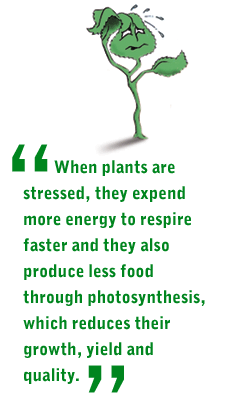


Sleeping Plant’s “Breath” Indicates Its Health
by Susan Varlamoff


Illustrations: Jay Bauer
A plant’s nighttime respiration, or “breathing,” may hold clues about its exposure to unseasonable temperatures, damaging pests, dry soil or other environmental stressors. And knowing more about plant stress levels might help farmers detect trouble and intervene before that trouble gets out of hand, said Monique Leclerc, an environmental physics professor at the University of Georgia.
When plants are stressed, they expend more energy to respire faster and they also produce less food through photosynthesis, which reduces their growth, yield and quality. Faster nighttime respiration means plants also produce more carbon dioxide — an indicator of stress — and they give off less water vapor (a process called transpiration), which increases their temperature.
“It is similar to a human being’s reaction,” said John Beasley, a UGA agronomist and member of Leclerc’s research team. “If you can’t perspire, your body overheats and your respiration rate increases.”
For the past two summers, the team has studied carbon dioxide fluxes in fields of peanuts to correlate environmental stress levels with nighttime respiration rates. Initial results indicate that peanuts emit higher levels of carbon dioxide when stressed by low levels of soil moisture.
In each locale, the researchers have installed an array of equipment to collect data on rainfall, air- and soil-moisture levels, air and soil temperatures, and solar and Earth radiation in the peanut fields. They also use solar-powered sensors to measure wind speed and direction, and infrared gas analyzers to record carbon dioxide uptake by peanut plants, which helps determine fluctuations in carbon dioxide concentrations. The combined data help the scientists interpret microclimatic influences not only on carbon dioxide respiration but also on plant growth and yield. Moreover, because data are collected from the time the seeds are planted until the peanuts are harvested, the team can study variations in carbon dioxide fluxes throughout the plant’s life cycle. In particular, the scientists can see how such fluxes are related to water stress at different stages of plant growth.
In addition to Beasley, Leclerc’s team includes research scientist Anandakumar Karipot, postdoctoral fellow Gengsheng Zhang, UGA doctoral student Natchaya Pigintha and plant physiologist Diane Rowland of the U.S. Department of Agriculture.
In 2004, the team chose an irrigated peanut field at UGA’s Southwest Georgia Research and Education Center in Plains, Ga. Because this field is large, flat and fairly uniform with similar soil properties throughout, Karipot said, similar conditions exist for all peanut plants; carbon dioxide variations in virtually any sample are deemed representative of the whole crop.
The group continued its work in summer 2005, this time intentionally growing peanuts in a field (in Vienna, Ga.) that was neither irrigated nor uniform. “These contrasting site features give us an opportunity to compare plant respiration under different terrain and atmospheric conditions,” Karipot said.
They brought in additional instruments in 2005 to monitor carbon dioxide levels in the soil. They also deployed a second system to measure variability in respiration rates, even over short distances within the field, resulting from differences in soil conditions and small-scale terrain.
Next summer, Leclerc said she plans to add further refinements, such as collecting data on prevailing winds. She also wants to install a wireless data-transmission system to receive continuous communication of field conditions, uninterrupted by power outages, lightning strikes or cables that have been chewed through by rodents.
The team has a major payoff in mind: to develop simple technology to aid growers’ on-the-spot decision making. “One of our long-term goals,” Leclerc said, “is to come up with ways to tell farmers that their plants are stressed so they know when to irrigate.”
For more information, contact Anandakumar Karipot at akaripot@griffin.uga.edu or Monique Y. Leclerc at mleclerc@griffin.uga.edu, or access http://www.griffin.uga.edu/ grf/station/mleclerc/mleclerc/ v02_index.html.
For comments or for information please e-mail: rcomm@uga.edu
To contact the webmaster please email: ovprweb@uga.edu
![]()